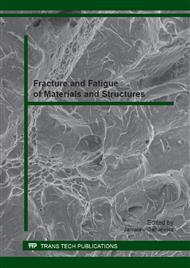p.113
p.119
p.125
p.133
p.141
p.147
p.153
p.160
p.168
Improving Fatigue Life of Riveted Joints by Rivet Hole Sizing
Abstract:
The aim of this paper is to assess the impact of the rivet hole sizing process on the fatigue life based on the example of the structural connections characteristic for riveted joints used in aviation industry. Test specimens reflected the structural connection consisting in a riveted lap joint of an airplane plating stiffened with a T-bar. Connected plates and the T-bar are made of D16CzATW aluminum alloy. 3 mm diameter oval head solid rivets for aviation-related purposes were made of PA24 aluminum. During fatigue tests, individual specimens with non-sized holes and with sized holes were subjected to uniaxial, one-sided, fixed-amplitude loading (R = 0). It can be concluded from the fatigue life comparison that introduction of an additional operation in the riveting process, i.e. the hole sizing, results in significant, about two-fold increase of the fatigue life of the riveted structural connection, even at slight sizing degree. The difference of the specimen damage nature was observed between specimens with sized and non-sized holes.
Info:
Periodical:
Pages:
141-146
Citation:
Online since:
January 2014
Authors:
Keywords:
Price:
Сopyright:
© 2014 Trans Tech Publications Ltd. All Rights Reserved
Share:
Citation:


